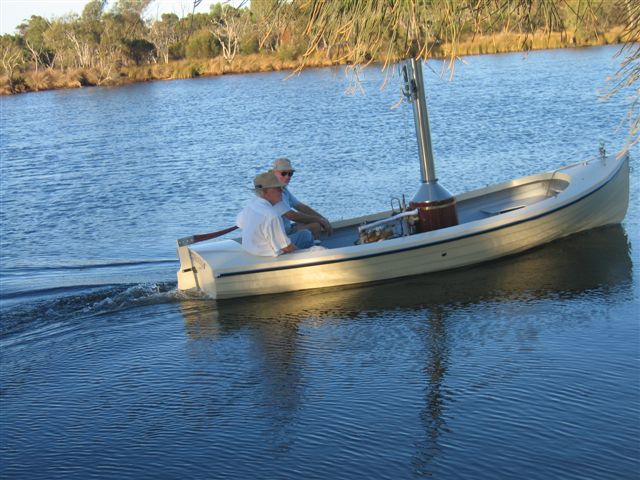|
For me, the classic steamboat, has a round tail with gently curved line over the screw. That will be called counter stern ,yacht stern or duck-tail stern. Here is a very successful example in a small size:
Pauline 5,50 m x 1,65 m or equal to 18'-1" x 5'5" for the "foot lovers".

Looks nice, but has the disadvantage that on the last 0.5 m of the boat
absolutely no buoyancy is produced. Also on the rest of the boats last quarter does not exist
all too much boost. Pauline is beautiful here in the water line, the engineer is sitting near the boiler.
So also his weight is almost in the middle of the boat.
If you focus more on a short boat, rather than my arbitrarily defined beauty, the transom stern is
the first choice. It gives the boat additional virtual water line length at
the calculation of the hull resistance. Easy to understand, since the water flow here
is not disturbed and can braek at the transom without building extra resistance.
Even long boats make advantage of this effect and thus achieve also high
hull speeds because of low form resistance. -> additional specification: Transaom Stern!
Sunrise is with 5,10 m x 1,90 m = 16'-9" x 6'-3" also a beautiful little with transom stern. It is built in a honest strip construction and is probably 2011, the first time go into the water. Sunrise is because of its great freeboard and also the large width of 1.9 m (length to width = 2.68: 1) a very seaworthiness boat and has large loading capacity. Since I'm at home still have the heavy Emma, I don't need so much space.

Bethany is with 4,88 m x 1,83 m = 16' x 6' (L : B = 2,66 : 1)
not a slim vessel. Thanks to the low freeboard, it looks still quite dynamic - but of course loses seaworthiness by this feature.

The aft deck brings the passengers already a little nearer to the center of gravity. If you would move the boiler
a little forward, the boat should also lie with 2 people in the back on the water line - or you should always have a third
passenger in the bow. -> additional specification: long aft deck for best trim.
Generally, this image shows also that the displacement of a human payload of 100 kg of course with a 600 - 800 kg boat
has much greater effect on the trim, than on larger and heavier boats. This in turn results in the requirement,
to design the layout and plan the load distribution of a small boat quite carefully. A lot of thoughts about the future use of the boat included.
On Don Camillo 4,88 m x 1,65 m = 16' x 5'-5"
the matter of trim is solved quite perfect. The transom stern and the long aft deck are bringing the human load close to the center of gravity.

The perfect wood work will be accenturated by the low bow and aft deck. But if you have an otherwise calm waters also with other sportsmen or even to share with commercial shipping, I personally would like to have more freeboard as protection against water coming in. -> Entry into the specifications: no low lying decks!
Bonnie Jean 4,88 m x 1,63 m = 16' x 5'-4"
breaks with a length to width ratio of 3:1, the "beauty line" from "equal or better than 3 : 1. Even more to the freeboard against Don Camillo is not harmful for my eyes to good proportions. You have to try how well the backrest of the green bow bench would protect you against over coming wave splashes.
-> Entry into the specifications: length to width ratio equal or better than 3

Orion don't fit here necessary because of its dimensions of 8 m x 2 m = 26'-3" x 6'-7".
But this photo proves the benefits of a coaming (edge to the interior).
You can keep the low freeboard elegant without loosing seaworthiness.
-> Entry into the specification: sufficiently high coaming for better seaworthiness !

Specification - Part 2
| Transom Stern | high buoyancy at the stern |
| | low form resistance |
| Aft Deck | long aft deck for best trim. |
| Proportion of the hull | Length to width ratio equal or better than 3 : 1 |
| Seaworthiness | Little rivers and lakes shared with commercial shipping |
| | no low lying deckss |
| | sufficiently high coaming |
|





